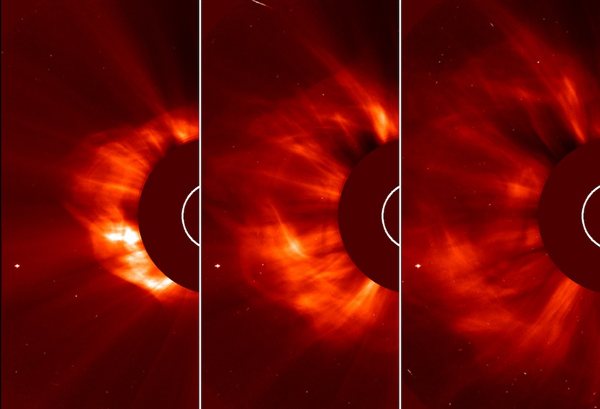Coronal mass ejections usually occur after solar flares on our active Sun. NASA’s Solar Dynamics Observatory caught April 11’s M6.5-class flare on camera. Don’t look straight at it. // NASA/SDO
Yesterday at 3:36 A.M., the Sun launched billions of tons of plasma into space at 600 miles per second (966 kilometers/second) — 37 times as fast as our fastest spacecraft. This event, called a coronal mass ejection (CME), sent charged particles and radiation hurtling toward Earth.
The radiation, traveling at the speed of light, reached Earth in the usual 8.5 minutes, but the particles, slowed down by their pesky mass, will take 1−3 days to get here. The radiation caused a brief radio blackout when it reached the part of the atmosphere where GPS and communications information zips around, but all is well now, and scientists predict no major “space weather” issues.
In order to affect Earth at all, a CME’s path must be in line with Earth. And even if one is headed toward us, the radiation can’t penetrate all the way through our atmosphere and reach the ground. But if you’re currently hanging out in Alaska or Norway or Siberia, a) that’s awesome, and b) look up at the sky in 1−2 days to see the spectacular northern lights that will occur as the solar particles, channeled along Earth’s magnetic field lines, collide with particles in the upper atmosphere.
This CME is associated with a mid-level M-class flare that peaked at 3:16 A.M. The flare, though 10 times weaker than an X-class flare, is the strongest so far in 2013. Expect more solar excitement in the near future, as we’re churning toward “solar maximum,” the part of the Sun’s 11-year activity cycle when the star is the most dynamic. Scientists expect this peak to occur late this year.

The Solar Heliospheric Observatory (SOHO) captured April 11’s coronal mass ejection (CME) as the plasma separated from the Sun and began its journey toward Earth. Click on the image to see an animated view of the CME. // ESA/NASA/SOHO/GSFC